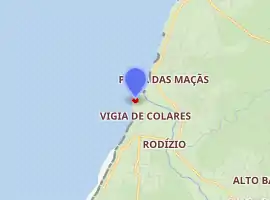Archaeological Site of Alto da Vigia
The Archaeological Site of Alto da Vigia (Portuguese: Estação Arqueológica de Alto da Vigia) is an archaeological site associated with Roman interventions in the Portugal, situated along the Praia das Maçãs in the civil parish of São João das Lampas e Terrugem, in municipality of Sintra.

Location of the site in the municipality of Sintra | |
| Location | Lisbon, Greater Lisbon, Lisbon, Portugal |
|---|---|
| Coordinates | 38°49′25″N 9°28′18″W |
| Altitude | 20 m (66 ft) |
| Type | Necropolis |
| Length | 19.25 m (63.2 ft) |
| Width | 22.5 m (74 ft) |
| Site notes | |
| Archaeologists | unknown |
| Ownership | Portuguese Republic |
| Public access | Private |
| Website | Official website |
History
The existence of a Roman sanctuary dates to the 2nd to 3rd century A.D., when the lands overlooking the coast were dedicated to Sun, Moon and Imperial cult.[1] At that time a circular temenos, an open air religious space, was used by holders of high imperial positions in the territory.
Little is known about the intervening years, although a Moorish settlement occupied the lands sometime in the 12th century.[1] The group eventually disappeared, and the area was abandoned. Much of the stonework was used by locals to build their own residences or used in public construction.[1]
The re-discovery of these ruins date back to Valentim Fernandes in 1505; and Francisco d'Ollanda, around 1541, with the latter including designs and observations of the structures, which he observed were a Roman sanctuary.[1] The identification of these ruins, corresponded to the first archeological discovery in Portugal. Its importance was largely recognized by the number of local, national and international visitors during the Renaissance.[1] Among the illustrious visitors were members of the Portuguese Royal Family, namely King D. Manuel, and later, the Infante D. Luís, brother of King D. John III.[1]
These descriptions suggest that the site was visitable during the 16th century, at a time when the structures were largely submerged in the sand.[1] Yet, local memory helped the stories to continue, and the existence of a Roman sanctuary along the Sintrense beach remained in the minds of locals, even as its specific location could not be identified.[1] Various studies and scientific work finally identified its presence on a small hilltop escarpment overlooking the Praia das Maçãs, known locally as the Alto da Vigia and Alconchel.[1] A team from the Archaeological Museum of São Miguel de Odrinhas began excavations in 2008, alongside a tower structure, unearthing a monumental Roman sanctuary.[1]
Architecture
The site is situated above cliffs overlooking the beach of Praia das Maçãs, on barren lands. The complex includes a Roman sanctuary and a tower dating from the 16th century.[1] In addition, there were also identified vestiges from the Islamic epoch, totally unknown until their discovery, although the toponymy Alconchel (al-concilium) may have alluded to its presence.[1] Architectural artefacts from the Moorish period correspond to a ribat (or convent) that included various halls, with a mirhab oriented towards the southwest (in the direction of Mecca).[1] The remaining materials associated with the Moors are residual, and include ceramics from the 12th century (likely associated the final phase of occupation), as well as shells and fires (suggesting a link between the coastal activities and food for these locals.[1] In addition to the buildings, an area of graves were identified without any artefacts linked to the Islamic presence.[1] The structures of the ribat also reused many of the architectural elements of the Roman epoch, that identifiable by the inscriptions, already identified by Fernandes and d'Ollanda during their excavations in the 16th century.[1]
The importance of the sanctuary during the Roman period is reflected in the votive inscriptions, expressing health to the Emperor and long life to the Empire.[1] These wishes are not normally associated with particular devotees, nor by local or provincial elites, but suggest that they were contracted by members of the Imperial class, namely governors of Lusitania or Imperial legates, by way of the Senate of Olissipo.[1] The inscriptions were dedicated by Sextus Tigidius Perennis, governor of Lusitania, to the Soli et Lunae in 185 AD; between 200 and 209 by Junius Celanius, a governor, to the Soli aeterno Lunae and by Caius Julius Celsus, procurator province Lusitaniae in the late 2nd century.
During excavations an inscription was recovered that attests to the importance of the local, since it was dedicated to the Sun and the Ocean, by a procurator of Agustus Cesear, and his family.[1] In addition to the altar and funerary inscription, there were other Roman architectural elements discovered on the site, including a framed pots, fragments of columns and altars and large blocks for construction.[1]
References
- "Excavação Alto da Vigia" (in Portuguese). Sintra, Portugal: Museu Arqueológico de São Miguel de Ordinhas. 2015. Retrieved 29 March 2016.